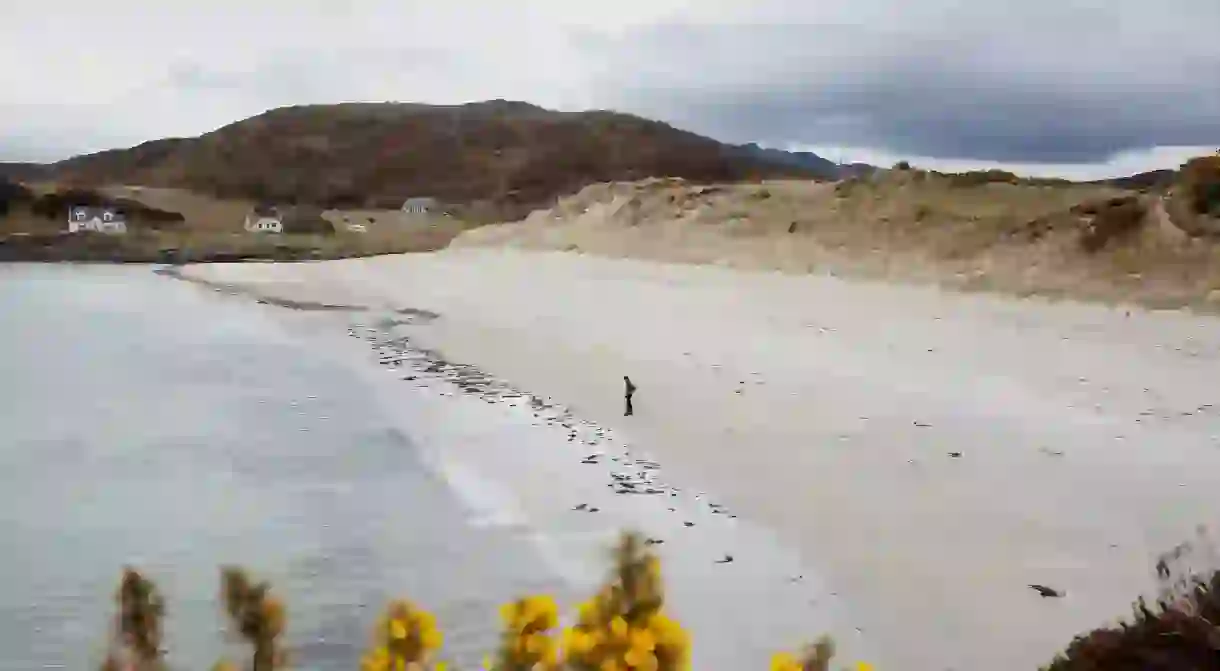A Guide to Scotland’s Hidden Film Locations

Paid partnership with

Famed for its rich heritage and its spectacular and enduring landscapes, Scotland is the perfect backdrop for the world of cinema and TV. We take a look at a few of the unique locations that have featured prominently in iconic films and series, from small remote islands to atmospheric glens.
Glen Feshie – A Wild Highland Glen
The magnificent Glen Feshie lies in the heart of the Cairngorms National Park. The Glenfeshie Estate, owned by conservation organisation Wildland, is home to one of the UK’s most ambitious rewilding projects and is renowned for its diverse and abundant wildlife including eagles, ptarmigans and wildcats. The miles of beautiful woodlands and moors running alongside the meandering River Feshie have been carefully managed and rewilded to preserve the last remnants of the ancient Caledonian Forest. It’s not surprising that the famous painting Monarch of the Glen by Edwin Landseer, of a majestic stag, is said to originate from here.
The only way to explore the Glen Feshie is on foot or bike. Trails trace the river deep into the glen, among old and newly planted Scots pines – the ‘flagship’ tree of the Caledonian Forest. It is the timeless beauty of Glen Feshie that makes it the perfect backdrop for period films and TV shows. Scenes of Queen Mary (played by Saoirse Ronan) and her court riding on horseback through the Scottish countryside in Mary Queen of Scots (2018) were filmed here. The historic Glenfeshie Lodge also stood in for the Royal Family’s Scottish home Balmoral Castle in The Crown and The Queen (2006).

Corrour – Britain’s Most Remote Train Station
Made famous in Danny Boyle’s Trainspotting (1996) when character Tommy drags his unenthusiastic friends on a walk in “the great outdoors”, Corrour Station is a remote train station on Scotland’s West Highland Railway line. Located in the middle of the sprawling Rannoch Moor, Corrour has no road access and is known for its remote and unspoiled wilderness.
The area is popular with walkers and cyclists who come here to explore the nearby Munros and scenic lochs. As you need to plan a trip here around the rail services, it’s worth spending the night. The Corrour Station House has been lovingly reimagined as a cosy restaurant with B&B rooms. The relaxed restaurant serves hearty homemade food by a roaring fire. Accommodation is in the converted Signal Box and includes three ensuite rooms with 360-degree views. Corrour Estate, who own the Station House, also offer guests staying there or in their self-catering cottages activities including clay pigeon shooting and sauna sessions on the tranquil Loch Ossian.

Barra – A Small Outer Hebridean Island
Sitting near the southern end of the island chain of the Outer Hebrides, Barra is known for its stunning sandy beaches and rich cultural heritage. The island is also home to what is believed to be the only airport in the world where scheduled flights, operated by Loganair, use a beach as a runway. Though in 1941 it was a ship, not a plane, which ran aground on rocks off the nearby island of Eriskay with 50,000 cases of whisky on board. It was this story that inspired Barra resident Compton Mackenzie to write the 1947 novel Whisky Galore, which was adapted two years later into a British comedy film, most of which was shot on Barra.
In the film, islanders sneakily salvage and hide the shipwreck’s cargo of whisky, despite a wartime ban by the authorities. Many scenes were filmed in the island’s main village Castlebay, featuring landmarks such as the Lady of the Star of the Sea church and the medieval Kisimul Castle. Many of the cast and crew for the film were locals from Barra who had no previous acting experience and were said to have each been given a bottle of whisky at the end of filming for their hard work and enthusiasm.

Culross – A Timeless Cobbled Village
The peaceful village of Culross is Scotland’s best-preserved example of a 17th-century burgh. Situated on the north shore of the Firth and Forth, the village’s winding streets led to a once-thriving seaport. The white-harled houses and colourful buildings including Culross Palace have been featured in multiple films and TV series including Outlander, Kidnapped (1971) and The Little Vampire (2000). In Outlander, Culross acts as the fictional village of Cranesmuir and features the dramatic scene where a young boy has his ear pinned to a post in Mercat Cross after being caught stealing.
Today Culross Palace and its beautifully reconstructed period garden is looked after by the National Trust of Scotland and open to visitors from April to October. You can also experience the relaxed pace of village life by staying in The Dundonald, an elegant guesthouse and cottage housed in an old coaching inn.

Red Point – A Secluded West Coast Peninsula
Reached at the end of a single-track road along the west coast south of Loch Gairloch, Red Point is a low promontory with two reddish sand and shingle beaches. The beaches were featured in the 2014 film What We Did On Holiday when Billy Connolly’s character takes his grandchildren for a day out that ends in tragedy.
The largest beach is backed by dunes, has wonderful views of the islands and rock pools to explore. There is also a lovely coastal walking path that leads south to the remote fishing and crofting township Diabeg.

To find out more about Scotland’s spectacular film locations head to VisitScotland












